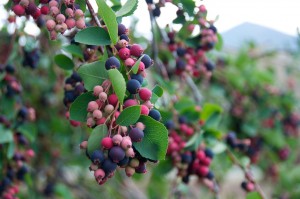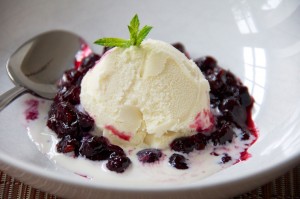THE MAGICAL COMBO of salty pig and fruity Cantharellaceae cannot be overstated. In this case I paired prosciutto with black trumpets, a match that took an already scrumptious dish—classic ricotta gnudi—over the top. But why stop there?
So I shaved some Oregon white truffle on top.
A Few Words on Making Gnudi
Most gnudi recipes call for egg and flour to be mixed with the ricotta. These ingredients undoubtedly help to bind the gnudi and allow them to stand up to the boil—or even survive a subsequent pan fry intact. My Stinging Nettle Gnudi is just such a recipe, and it’s delicious. But for the most tender and fall-apart goodness imaginable, you only need ricotta, or a mixture of ricotta and parmesan, along with an outer shell of semolina.
The main drawback is that you need to refrigerate the gnudi for at least a 24-hour period. Two days is even better, and three days is not unheard of. The semolina, as I understand it, helps to draw moisture out of the cheese, solidifying the gnudi, but sufficient time and cool temperatures are necessary.
This is the most tender and delicate gnudi I’ve ever tasted. They require care. Although this recipe will make enough for four, my advice is to make it for yourself the first time around, or for two. The leftover gnudi can remain in the fridge another day or two. Most recipes tell you to boil the gnudi for two or three minutes and remove after they float to the surface; these only need a minute in gently boiling water, and they might not float. Capture with a slotted spoon, then carefully place on a paper towel. The first time I made them, I tested eight in a rolling boil. Four survived. After that I reduced the heat and the cooking time for a 100 percent success rate.
Sauce:
2 tbsp butter, divided
1 small shallot, diced
1 handful black trumpets
vegetable oil
4 slices prosciutto, torn into pieces
chicken stock
parsley
parmesan cheese, grated at table
white truffles, shaved at table (optional)
salt and pepper, to taste
1. In a lightly oiled saute pan over medium heat, cook prosciutto pieces for a minute per side until slightly wrinkled and crispy. Remove to paper towel.
2. Melt 1 tablespoon butter in same saute pan and add diced shallot, stirring for a minute. Add black trumpets and cook together a few minutes, seasoning to taste. Deglaze pan with a splash of chicken stock if necessary, then remove pan contents to a bowl.
3. Melt 1 tablespoon butter in same pan over medium heat, add a quarter cup of chicken stock and whisk together, reducing. More chicken stock can be added and reduced later if necessary. Or, for a more decadent touch, add some cream.
4. Meanwhile, bring a pot of salted water to a light boil. Add gnudi and cook for about a minute before removing to paper towels with a slotted spoon.
5. Add prosciutto and mushroom-shallot mixture back into sauce pan, stirring.
6. Carefully plate gnudi and pour over sauce. Garnish with chopped parsley, optional truffles, and grated parmesan.
Like this:
Like Loading...
 IN EASTERN WASHINGTON, wild Saskatoons (Amelanchier alnifolia)—aka western serviceberry, shadbush, and juneberry—grow near the extensive orchards of cherries, apples, and pears that follow the river valleys. It’s interesting to see how this free food is all but ignored.
IN EASTERN WASHINGTON, wild Saskatoons (Amelanchier alnifolia)—aka western serviceberry, shadbush, and juneberry—grow near the extensive orchards of cherries, apples, and pears that follow the river valleys. It’s interesting to see how this free food is all but ignored. A Saskatoon sauce is just the thing this time of year to dress up a scoop of vanilla ice cream. Or you can add some vinegar and herbs to make a savory sauce.
A Saskatoon sauce is just the thing this time of year to dress up a scoop of vanilla ice cream. Or you can add some vinegar and herbs to make a savory sauce. 2 cups Saskatoon berries
2 cups Saskatoon berries




































